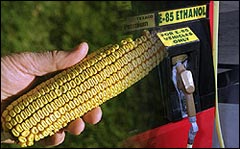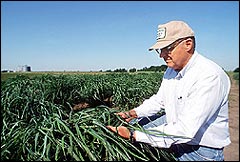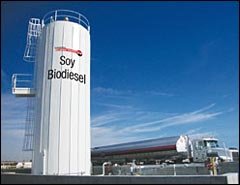America devours oil like no other country in the world. Representing 5 percent of the global population, the country consumes fully a quarter of the world’s oil. Every year, to move ourselves and our goods around, we burn 140 billion gallons of gasoline and 40 billion gallons of diesel — enough to propel the average U.S. car around the world 1.6 billion times. But rising prices, climate change, and seemingly endless crises in the Middle East have sparked a reckoning.

We love to pump, and it shows.
Photo: hawaii.gov
While there is plenty of disagreement about how best to end what President Bush has called our “addiction to oil,” a rough consensus has formed in support of biofuel as an alternative to crude oil. But biofuel — energy gained from plant or animal matter — is a broad category. The term lumps together a number of energy sources that are, in fact, quite different, from turkey innards to corn stalks. (Mmm, sounds like Thanksgiving dinner.)
So far, three fuels have emerged to lead the U.S. biofuels pack, whether in practice or in our collective imagination: corn ethanol, cellulosic ethanol, and biodiesel.
They are hailed as carbon-neutral solutions for an emissions-happy era. And in one sense, all biofuels can indeed be thought of as CO2 neutral, since any carbon released at the tailpipe was recently captured by the plants for photosynthesis. But plant-derived fuel doesn’t emerge from a vacuum. Crops must be cultivated, harvested, moved, and transformed — processes that are hardly carbon neutral. And here is where the vast discrepancies cloaked by the term “biofuels” emerge.
Conventional Ethanol
People have been making conventional ethanol for about as long as they’ve been getting drunk. Creating it involves leaching simple sugars from plant matter and fermenting them into alcohol, just like the process for making “corn liquor,” or moonshine. It’s affordable and effective — Henry Ford even reckoned that ethanol would power his Model T cars. (Presumably he was sober at the time.)

What about cob?
Photo: eere.energy.gov
Since conventional ethanol relies on simple sugars, it works best when derived from crops that concentrate starches in their seeds. That’s why corn makes a better feedstock than wheat, and sugarcane makes a better feedstock than corn. But the same quality also limits conventional ethanol’s efficiency when it comes to mass production: since it can use only a relatively small portion of each plant, a lot of biomass goes unused in the process.
In the United States, corn, the nation’s most prolific crop, is by far its dominant ethanol feedstock: some 95 percent of all ethanol produced in the U.S. comes from the starchy yellow kernels. Corn-based ethanol remains the only biofuel produced in serious quantity in the U.S., though biodiesel is making a push (see below). Yet even after brisk recent growth, ethanol producers will churn out the equivalent of just 3 percent of U.S. gasoline consumption in 2006.
Still, production trends point steeply upward. Output was 3.9 billion gallons in 2005, and increased to a projected 4.8 billion gallons for 2006 — the largest jump in production since 1980, the year industry began tracking such data. Production is expected to swell to 7.5 billion gallons in the next few years, and the number of ethanol plants under construction in the U.S. has gone from 16 in 2005 to 33 today.
Rising oil and gasoline prices have clearly spiked recent interest in ethanol, but its boom in popularity has other sources too. The Energy Policy Act passed by Congress in 2005 includes a Renewable Fuel Standard stipulating that gasoline sold in the U.S. must include a certain amount of renewable fuel. This year, 4 billion gallons of renewable fuels must be used in gasoline, rising to 7.5 billion gallons by 2012. Gasoline refiners have also begun turning en masse to ethanol as an alternative to the octane booster MTBE, which many states have recently banned.
Among environmentalists, however, the growing consensus is that corn-based ethanol is more fool’s gold than eco-treasure.
Conventional agriculture relies on fertilizer and pesticides derived from fossil fuels. Diesel powers the tractors and other machinery that plow, plant, and spray crops, as well as the vehicles that haul away the final product (due to ethanol’s tendency to absorb water, it must be transported in special containers on trucks or trains instead of in the cheaper pipeline system used for oil and gasoline). Figure in the fuel — mainly coal and natural gas — burned in the distillation process, and experts reckon each gallon of ethanol takes the energetic equivalent of roughly three-quarters of a gallon of ethanol to produce.
Then there are greenhouse-gas emissions. After accounting for the coal and natural gas burned to process it, the nitrous oxide — a greenhouse gas hundreds of times more potent than CO2 — generated from fertilizer production, and other factors, a recent study in Science found that ethanol use reduces greenhouse-gas emissions by just 13 percent compared to gasoline use.
Despite its clearly limited environmental benefits, domestic ethanol draws plenty of help from Washington. Since 1978, the fuel has qualified its producers for a federal tax credit, which now stands at 51 cents to the gallon. Ethanol producers also benefit from a 54 cent-per-gallon tariff on sugarcane ethanol imported from Brazil — a country where production is not only cheaper but more efficient, given sugarcane’s superiority as a feedstock.
And now U.S. automakers, also with a boost from Washington, are jumping on the ethanol bandwagon. Advertising campaigns like GM’s “Live Green, Go Yellow” are plugging flex-fuel vehicles capable of running on gasoline or a mixture of gasoline and ethanol. E85 — a mix of 85 percent ethanol and 15 percent gasoline — can now be pumped at some 650 service stations nationwide, a threefold increase since 2004. And at the same time, the federal government’s “dual-fuel loophole” provides automakers a 1.5 mile-per-gallon credit toward meeting fuel-economy standards — without requiring that flex-fuel vehicles actually run on alternative fuel.
The government estimates that flex-fuel vehicles run on ethanol blends less than 1 percent of the time, hardly surprising since the E85 infrastructure has a long way to go before it catches up to gasoline. As a result, even while 2005 saw more flex-fuel vehicles on the roads than ever before, Americans consumed 80,000 more barrels of oil than in the previous year. Meanwhile, legislative plans are on tap to either increase the credit for selling flex-fuel vehicles or extend it beyond 2014, effectively removing any incentive for carmakers to move toward lighter, more efficient vehicles.
Ethanol’s proponents argue that a homegrown fuel could be good for the American farmer. Alas, these tax credits and import tariffs accrue not in the bib pockets of corn farmers, but in the well-lined coffers of companies that blend ethanol with gasoline. Archer Daniels Midland, the largest of the processing firms, controls an estimated 40 percent of the ethanol market, while the top 10 producers together control an estimated 70 percent. To date, farmers own less than half of all ethanol plants on line, according to statistics compiled by the Renewable Fuels Association. So this homegrown dream may be something of an industrial nightmare.
Cellulosic Ethanol
If criticism of corn ethanol grows even as production booms, the opposite problem haunts cellulosic ethanol. Nearly everyone loves the idea of it, yet no one’s making it on a commercial scale.

Switchgrass may be our salvation.
Photo: usda.gov
Cellulosic ethanol, a fuel chemically identical to the conventional kind but instead derived from “biomass,” a term encompassing everything from waste materials like corn stover and paper pulp to fast-growing plants like switchgrass, willow, and poplar. Roughly two-thirds of this cellulosic matter is complex carbohydrate, which can be broken down into fermentable sugars, and from there, into ethanol. Lignin makes up the remaining dry weight and carries an energy content similar to that of coal. Most models of cellulosic ethanol production, in fact, use lignin combustion to power the process, thereby closing the energy loop.
As end products, cellulosic and conventional ethanol are indistinguishable; gallon-for-gallon, both yield roughly two-thirds the energy of gasoline. But take into account the resources it takes to churn out a gallon of corn ethanol versus a gallon of ethanol from cellulose, and their energy profiles could hardly be more different.
According to the U.S. Department of Energy, corn-based ethanol provides 26 percent more energy than is required for its production, while cellulosic provides 80 percent more energy. And while conventional ethanol reduces greenhouse-gas emissions 10 to 20 percent below gasoline levels, the reductions with cellulosic range from 80 percent below gasoline to completely CO2 neutral.
Switchgrass — a word first heard by many in the notorious “addiction to oil” speech — holds the key to large-scale and ecologically sound ethanol production, many think. A perennial prairie grass native to North America, switchgrass requires little water or fertilizer to grow and thrives in places unsuitable for most crops, ranging from the Gulf of Mexico to Canada and from the Atlantic to the Pacific. Some five to nine feet tall, this gangly weed also yields twice as much ethanol per acre as does corn.
But do we have enough land to support a cellulosic-ethanol industry without also competing with food or destroying the environment? The answer is … maybe. According to a recent study from the University of Tennessee, as many as 100 million acres of cropland and pasture will need to be devoted to switchgrass to produce enough ethanol to offset 25 percent of petroleum use. Currently, U.S. farmers have about 80 million acres in corn, 15-20 percent of which goes into ethanol production.
Since land scarcity will clearly be an issue, some analysts argue that any biofuel strategy will need to be accompanied by a strong dose of conservation. According to “Growing Energy,” a 2004 Natural Resources Defense Council report on biofuels, the U.S. is on track to consume 290 billion gallons of gasoline for transportation in 2050. By boosting fuel efficiencies and reigning in urban sprawl, the report says, we could feasibly cut this figure down to 108 billion gallons.
So here’s where the mathematics of biomass come in. NRDC has forecasted that the number of gallons of ethanol produced per ton of dry switchgrass could jump from 50 gallons to 117 gallons by 2050. Crop experts say that current averages of five dry tons of grass per acre could easily double under a standard breeding program. These combined boosts in efficiency mean that enough switchgrass could be grown on a reasonable chunk of land to produce 165 billion gallons of ethanol by 2050. And because one gallon of ethanol contains 66 percent of the energy content of gasoline, 165 billion gallons of ethanol equates to — you guessed it — 108 billion gallons of gasoline.
It’s an optimistic scenario, to be sure. On the efficiency side, it demands radical cuts in fuel usage. On the ethanol side, it requires an infrastructure of pipelines and pumps specially designed to transport the hygroscopic fluid. (Railcars and barges currently do the job, but this adds to both CO2 emissions and expense.) More tricky is the problem of the ethanol production itself. Cellulosic biomass is bulky and materially complex, unfit for the same methods of ethanol extraction used with corn. In order to even get the stuff into manageable form, processors must soak it in a pre-treatment bath, followed by an acidic or enzymatic digestion that splits it into simple sugars.
Researchers are now trying to engineer a bacterium that can chomp through all of these sugars at once, but for now the multistep digestion procedure is a requirement. The future of ethanol production will rely not only on streamlining that digestion, but on combining all processes — from pre-treatment through fermentation — in a single genetically engineered microorganism.
In short, the shining promise of cellulosic is still just that. “The prospects for ethanol from cellulose may be more promising than is the case for corn, but the benefits, assuming they exist, surely lie a decade or more in the future,” wrote Harvard environmental studies professor Michael McElroy in a recent article in Harvard Magazine. “The best, immediate option would be to conserve: to use less gasoline.”
Biodiesel
Imperatives to use less gas, unfortunately, are not something most Americans swallow easily. Images of drive-in movies, drive-thru restaurants, and the wide open road, after all, speckle our formative history. But some very American icons, ranging from Willie Nelson and Neil Young to Julia Roberts and Morgan Freeman, are hoping to lessen the impacts of our four-wheel love affair by championing biodiesel — a fuel usually derived from soybean, palm, or oil-seed plants like canola and mustard, but also acquirable from waste animal and vegetable fats, and even, surprisingly, algae.

Biodiesel: not just for hippies anymore.
Photo: fueleconomy.gov
Begun as a grassroots network of brewers that — without subsidies or government regulations — maintained a countercultural, anti-establishment aura, the biodiesel industry is rapidly turning mainstream. According to a recent article in the New York Times, about 76 commercial biodiesel plants are in production today, up from 22 in 2004. Even these can barely keep pace. Nationwide consumption of biodiesel tripled from 25 million gallons in 2004 to 75 million in 2005, and was expected to quadruple from that in 2006, reaching 300 million gallons. Accordingly, 50 new larger-scale plants are under construction.
These numbers still pale in comparison to Europe, where compression-ignition (diesel) vehicles are far more common than in the U.S., and where nearly 90 percent of all global biodiesel is produced and consumed. As demand rises, however, many E.U. countries will be hoping to fulfill their Kyoto Protocol requirements with fuel imported from Southeast Asia and Brazil. Japan, too, has expressed interest in obtaining biodiesel, as have India and China.
None of which is surprising, since as a substitute for regular diesel, biodiesel holds great appeal. Over its lifetime, pure biodiesel emits about 78 percent less CO2 than conventional diesel, according to a 1998 Department of Energy study [PDF]. Burning biodiesel also reduces emissions of smog-forming hydrocarbons and particulate matter by about 50 percent, and emissions of sulfur oxides and sulfates by 100 percent.
On the downside, all diesel engines — whether fueled by conventional diesel or biodiesel — still spew more toxic soot and smog-forming pollutants than gasoline engines, and this will likely remain true until cleaner “Tier 2” diesel emission standards go into full effect in 2009. So making the switch to biodiesel makes great environmental sense for the current fleet of diesel cars, buses, trucks, and heavy-duty equipment. But for individuals deciding on their next car purchase, a gasoline-powered hybrid (one that will soon be able to utilize cellulosic ethanol) remains the better choice.
That said, researchers at the University of Minnesota and St. Olaf College recently found that biodiesel production is highly efficient, generating 93 percent more energy than is required to make it. They also found that biodiesel reduces greenhouse-gas emissions by 41 percent compared with fossil fuels — strikingly less than the 1998 DOE study’s 78 percent, but still significant. When Tier 2 emissions standards bring biodiesel up to par with gasoline and ethanol for air pollutants, biodiesel seems like it should be a no-brainer for green energy.
And the Winner Is …
With the Middle East embroiled in conflict and evidence of climate change mounting, finding a viable source of renewable energy has never been so critical … or so in vogue. It is tempting, almost instinctive, to jump toward the most visible and abundant source for that energy — in this case, corn. Some say that corn ethanol could be a “stepping stone” to cleaner fuels like cellulosic ethanol. Perhaps. The danger is that the stepping stone becomes the destination — a substitute for meaningful change, squandering precious time and public faith when it doesn’t pan out.
When it comes to biodiesel, limitations on the scale of production may be the greatest weakness. According to the Minnesota research teams, if the entire American corn and soybean crop were diverted to biodiesel, that fuel would still satisfy only about 6 percent of diesel demand. To put that into perspective, in even the most optimistic 2006 production estimates, biodiesel will replace less than half of one percent of all diesel consumed. Ramping up worldwide cultivation of biodiesel crops is a possibility, but that will mean deforestation and the concomitant loss of biodiversity. If Brazil razes more of its jungle and Malaysia and Thailand theirs, little will be left of rainforests anywhere in the world.
Experts say that cellulosic ethanol stands a real chance to displace significant amounts of oil. But they also say this won’t happen without great financial support from both the public and private sectors. It won’t happen unless our political leadership implements greater efficiency standards and other incentives for companies to “go green.” It won’t happen unless we as individuals are willing to cut back on how much energy we consume, bottom line. And most important, it won’t happen unless we call for a change. Which, of course, is why it’s so important to understand why some changes are better than others.

